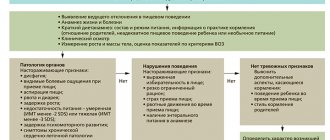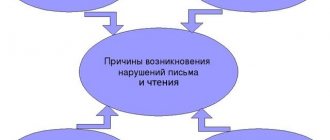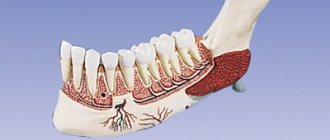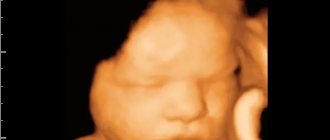Article:
Dyslalia is a defect in the pronunciation of sounds in children who do not have problems with hearing and normal innervation of articulation. Dyslalia in children manifests itself in the form of absence, replacement, or distortion of sounds. The word dyslalia comes from the Greek language, dys - disorder, lalia - speech. For this disease, a speech therapy study is carried out, during which mobility, the structure of the speech apparatus, and phonetic hearing are examined. Consultation with a neurologist, dentist, or otolaryngologist may be required.
General information about dyslalia
This speech disorder is not associated with damage and defects of the central nervous system and hearing. Dyslalia is the most common speech problem in children. It occurs in 25%-30%, and according to some data, in more than 50% of preschool children under the age of 7 years. 17-20% of junior schoolchildren and 1% of older students have various forms. In the structure of this disorder, polymorphic disorders in pronunciation stand out most of all.
They interfere with speech acquisition and are the causes of dysgraphia and dyslexia. This speech disorder is selective, meaning a child can pronounce up to 90% of words and sounds well, but have problems with the remaining 10%. Timely correction can completely rid a child of pronunciation problems.
Sound automation stage.
Automation of sounds is carried out consistently, through repeated training. Sound automation procedure:
- Isolated utterance;
- In syllables:
- in straight syllables (consonant + vowel);
- in reverse syllables (vowel + consonant);
- between vowels (vowel + consonant + vowel);
- in conjunction with a consonant sound (consonant + consonant + vowel);
- In words;
- In phrases;
- In sentences;
- In the text;
- In tongue twisters, pure tongue twisters, in your own speech.
Video: sound automation L
Symptoms of dyslalia
It is not difficult to see and recognize the symptoms of dyslalia; this can be done by paying attention to your child’s speech. Characteristic symptoms are distortions, replacement of sounds or letters with others. The baby may completely skip some letters in his speech. If substitution occurs, the symptom is a change in the audible sound to another, which is pronounced by the child. For example, a child hears the word “cat”, but pronounces “goshka”. This phenomenon occurs due to the fact that he cannot differentiate sound by articulation and acoustics.
The patient can replace phonemes with arbitrary ones, in a chaotic order, regardless of the structure of the word. There is no division into sizzling, hard, soft and other types. Sometimes a child can pronounce the same word in different ways, including correctly. This indicates incomplete acquisition of phonemes. A child suffering from this disorder can be identified by his speech and pronunciation. They use sounds and letters that are not in the word. This is usually typical for the mechanical type.
If a child has functional dyslalia, one or more sounds in his speech are replaced. Mechanical dyslalia is characterized by problems with the pronunciation of similar phonemes. If there are pathologies in the development of the lower jaw, they will be pronounced by anterior lingual articulation. This occurs due to the inability to hold the tongue on the front teeth. This speech disorder may improve as people get older.
If parents notice such a disorder and seek help from speech therapists, there is a high chance of completely getting rid of this disorder. If he does not receive proper correction, he is also likely to get rid of dyslalia with age. Such children have a rich vocabulary, can break words into syllables, and over time they will develop correct speech. Speech therapists identify physiological dyslalia, which goes away by the age of five.
Symptoms of deviation
Dyslalia is characterized by a wide variety of symptoms represented by omissions (complete loss of speech), substitutions (substitution of a different sound each time it occurs), distortion (abnormal pronunciation) and confusion of sounds (pronunciation is sometimes correct, sometimes incorrect). Various symptoms appear depending on the form of the disease:
- with functional, the pronunciation of one or more sounds is impaired
- with mechanical - a group of sounds similar in articulation;
- with physiological, age-related tongue-tiedness is observed, the cause of which is the immaturity of phonemic hearing and the inability to correctly control the movements of the speech organs, which naturally goes away by the age of 5.
Impaired sound perception
Fluent speech is essential for success in school. It is for this reason that speech needs to be given special attention. The process of formation of the speech apparatus is influenced by several factors, including hearing. Any auditory pathology negatively affects pronunciation. The child hears a word, sound, or letter incorrectly, and accordingly pronounces it incorrectly. Phonetic or sound perception is the ability to correctly hear and distinguish the sounds “P-B”, “S-Sh”, “L-R”.
Often, children with impaired sound perception distort even phonemes that individually they can pronounce correctly. They are unable to analyze their speech well, may make mistakes when writing, and have difficulty reading aloud. Such violations require work and correction by speech therapists and teachers. Many of these disorders can be eliminated in preschool age, preventing them from developing into a persistent form, which will be difficult to correct.
It is important to know that at school age speech develops very intensively, it is flexible and pliable. A child with impaired hearing may not perceive close and similar sounds. There are no words in his vocabulary that contain combinations of letters that are difficult for him to distinguish. This ultimately leads to the fact that he begins to lag behind his peers.
In turn, experts distinguish two types of functional dyslalia:
- sensory type - occurs against the background of neurodynamic disorders of the central part of the speech and hearing apparatus;
- motor variant - occurs against the background of neurodynamic disorders of the central part of the speech and motor apparatus.
Sensory dyslalia is characterized by a violation of the distinction between sounds that are similar to each other. When pronouncing, the child confuses hissing or whistling sounds, dull or voiced, hard or soft. Therefore, when he is asked to say, for example, “a word,” he can pronounce “shlovo,” that is, an interchange of sounds occurs. In addition to oral speech, if the patient takes dictation, he may make a similar mistake in writing.
Motor dyslalia is characterized by a discrepancy between the movements of the lips and tongue when pronouncing sounds. Articulation becomes blurred, and as a result, a phonetic defect appears.
In severe cases, it is possible to diagnose the totality of sound pronunciation, then the doctor diagnoses sensorimotor dyslalia. The degree of difficulty in pronunciation and differentiation of sounds by the patient may vary.
Classification
There are different types of dyslalia, which are classified according to the causes of occurrence, severity, and types of sounds with which the child has difficulty. Considering the causes of pronunciation disorders, mechanical or organic, functional varieties are distinguished. Speech therapists have developed the following classification of dyslalia.
Mechanical
Mechanical dyslalia is caused by the anatomical structure of the articulatory apparatus. The reasons are:
- Disturbed dental system. Prognathia may be observed - protrusion of the upper jaw, which appears due to its too active growth compared to the lower one. The bite of the teeth may be disturbed, the presence of a large gap when closing the jaws or a violation of the structure of the teeth. These deficiencies are corrected by dentists.
- Irregularly formed palate. It can be narrow, high, flat, which creates difficulties with the articulation of many sounds.
- Irregularly shaped lips. Insufficient lip mobility and sagging affect correct pronunciation.
- Short frenulum of the tongue (hyoid ligament);
- Anatomical feature of the structure of the tongue. It can be big, short, small.
Some of these reasons are easily remediable. This type does not affect the correct spelling or vocabulary.
Functional
Functional dyslalia is caused by social factors or correctable neurodynamic pathologies in the brain (brain cortex). There are several varieties - motor and sensory.
Motor type
Dictated by neurodynamic changes in the parts of the brain responsible for speech analyzers. Motor dyslalia is characterized by impaired movements of the tongue and lips, resulting in incorrect pronunciation. This phenomenon is called a phonetic defect.
Touch type
It is formed due to changes in the speech-auditory departments and affects hearing. The patient cannot differentiate sounds that have similar phonemes (hard-soft, voiced-voiceless, hissing-whistling). In speech, this leads to mixing, replacing, and omitting such letters, and in the future these letters can be omitted when writing.
The simultaneous presence of both types is called the sensorimotor type. Due to the unformation of certain sounds, three types of dyslalia can be distinguished:
- acoustic-phonemic,
- articulatory-phonemic;
- articulatory-phonetic.
Acoustic-phonemic
This group includes speech disorders due to the selective immaturity of the analysis of phonemes according to their acoustic parameters. The main violation in this case is insufficient sound perception, which is intended for recognition and differentiation by species. The sound that the child hears is recognized incorrectly by him, and therefore, he also pronounces it incorrectly.
It is important to know that with this type there are no hearing problems. The defect is selective for certain phonemes. Acoustic-phonemic dyslalia should not be confused with severe speech disorders.
Articulatory-phonemic
This group includes defects associated with the immaturity of operations for selecting phonemes according to their articulatory characteristics. There are two types of violations. In the first case, the articulatory base is not fully formed. Instead of the sound needed in this case, the child chooses a sound close to it in its articulatory characteristics.
The second option is characterized by the complete formation of the articulatory base. The child knows all the phonemes that are required for correct pronunciation, but when pronouncing words, some letters are replaced by others according to the principle of substitution. These substitutions occur according to the principle of articulatory proximity of phonemes - “rat” - “roof”.
Articulatory-phonemic
Characterized by defects in the sound design of speech due to improperly formed articulatory positions. Sounds can be pronounced in a distorted form, but this happens in unusual ways. This kind of speech is easy to understand.
Heaviness
Depending on the number of sounds that are pronounced incorrectly, dyslalia can be simple or complex. With a simple type, 1-4 sounds are impaired, with a complex type, more than four sounds are impaired.
Monomorphic type
It is difficult to pronounce one of the groups, for example, only voiced or only hissing.
Polymorphic
Sounds with which there are difficulties belong to different groups. Phonetic defects are designated by terms that are derived from the Greek alphabet:
- rhotacism – problems with the letter “P” and P is soft;
- lambdacism - “L” and “L soft”;
- sigmatism – the pronunciation of hissing sounds (zh, sh, shch, h) and whistling sounds (s, z) is impaired;
- iotacism – difficulties with “Y”;
- gammacism - “G” and “G soft”;
- kappacism - “K”, “K soft”;
- hittism – “X”;
- difficulties with voicing and deafening - replacing voiced consonants with voiceless ones and vice versa;
- softening and hardness defects - replacement of soft with hard ones or vice versa.
There may be complex forms that are combined in nature - the addition of several defects to each other. If there is a phonemic defect, that is, a sound replacement, the prefix “pair” is added to the name of the defect. This is how paralambdacism, parasigmatism and others are formed.
Article:
Dyslalia is a violation of sound pronunciation with normal hearing and intact innervation of the speech apparatus.
(“Speech therapy” edited by L.S. Volkova) Among the violations of the pronunciation aspect of speech, the most common are selective violations in its sound design with the normal functioning of all other utterance operations. These disorders manifest themselves in defects in the reproduction of speech sounds: distorted (abnormal) pronunciation, replacement of some sounds with others, mixing of sounds and, less often, their omission.
Classification D.
There are two main forms of D: functional and mechanical (organic).
Functional Dyslalia is a violation of sound pronunciation when there are no organic disorders, peripherally or centrally caused.
Mechanical Dyslalia – with deviations in the structure of the peripheral speech apparatus (teeth, jaws, tongue, palate).
FD occurs in childhood during the process of mastering the pronunciation system, and MD occurs at any age due to damage to the peripheral speech apparatus. In FD, the reproduction of one or several sounds may be impaired; in MD, a group of sounds is usually affected. In some cases, combined functional and mechanical defects occur.
FUNCTIONAL DYSLALIA
With FD, the specific speech skills to voluntarily take the positions of the articulatory organs necessary for pronouncing sounds are unformed. This may be due to the fact that the child has not developed acoustic or articulatory patterns of individual sounds. In these cases, one of the features of a given sound is not learned. Phonemes do not differ in their sound, which leads to the replacement of sounds . The articulatory base turns out to be incomplete, because not all auditory motor formations (sounds) necessary for speech have been formed. Depending on which of the signs of sounds - acoustic or articulatory - turned out to be unformed, sound replacements may be different.
In other cases, the child has formed all articulatory positions, but does not have the ability to distinguish some positions, i.e. make the right choice of sounds. As a result, phonemes are mixed, the same word takes on a different sound form. This phenomenon is called mixing or interchange of sounds (phonemes).
Cases of abnormal sound reproduction due to incorrectly formed individual articulatory positions are often observed. The sound is pronounced as unusual in the phonetic system of the native language in its acoustic effect. This phenomenon is called sound distortion .
To indicate distorted pronunciation of sounds, international terms derived from the names of the letters of the Greek alphabet are used:
Rotacism is a defect in the pronunciation R R R Lambdacism - L L Sigmatism - S S S Z Z Ts Sh Shch Zh Yotacism - Y Kappacism - K K Gammatism - G G Hitism - X X.
In cases where a replacement of sound is noted, the prefix para - is added to the name of the defect: pararotacism, paralambdacism , etc.
LEVELS OF IMPAIRED PRONUNCIATION
In a number of cases, children correctly use sound in isolation, in syllables, but do not use it in independent speech.
The fact is that children’s pronunciation skills correlate with the degree of complexity of the type of speech activity. O.V. Pravdina identifies 3 levels of impaired pronunciation:
inability to correctly pronounce a sound or group of sounds;
incorrect pronunciation of them in speech when correctly pronounced in isolation or in light words;
mixing two sounds that are similar in sound or articulation with the ability to correctly pronounce both sounds.
These data indicate that a child with impaired pronunciation goes through the same stages of sound acquisition as a normal child, but at some stage he may be delayed or stop.
MECHANICAL DISLALIA
impaired sound pronunciation caused by anatomical defects of the peripheral speech apparatus. It is sometimes called organic. The most common pronunciation defects are caused by: 1) anomalies of the dental system : diastemas between the front teeth;
2) absence of incisors or their anomalies; 3) incorrect position of the upper or lower incisors or the relationship between the upper and lower jaw (bite defects). These abnormalities may be due to developmental defects or acquired due to injury, dental disease or age-related changes. In some cases, they are caused by the abnormal structure of the hard palate (high vault). In such cases, the most frequently observed defects are whistling and hissing sounds, labial-dental, anterior-lingual, plosive, and less commonly P and Pb. Quite often, the pronunciation of vowel sounds is also disrupted, which become inaudible due to excessive noise in consonants and insufficient acoustic opposition of vowels.
The second most common group is made up of sound pronunciation disorders caused by pathological changes in the tongue : a tongue that is too large or small, a shortened hyoid ligament.
With such anomalies, the pronunciation of sibilants and vibrants suffers, and lateral sigmatism is also observed. In some cases, speech intelligibility suffers.
Pronunciation disorders caused by labial anomalies , because birth defects (various deformities) are overcome surgically at an early age.
In this case, the pronunciation of labial sounds is mainly impaired due to incomplete closure of the lips, as well as labiodental sounds. Sometimes there are defects in the pronunciation of labialized vowels (O, U).
However, anomalies of the organs of articulation do not always lead to pronunciation defects. This indicates the compensatory capabilities of a person: the same acoustic effect can be obtained in different ways.
Mechanical dyslalia can be combined with functional phonemic dyslalia.
In all cases of mechanical dyslalia, consultation (and in some cases treatment) of a surgeon and orthodontist is necessary.
SIMPLE AND COMPLEX DISLALIAS
Depending on how many sounds are pronounced defectively, dyslalia is divided into simple and complex. Simple (monomorphic) include disorders in which one sound or sounds of homogeneous articulation are pronounced defectively; complex (polymorphic) include disorders in which sounds of different groups (for example, whistling and sonorants) are pronounced defectively.
AGE-RELATED (PHYSIOLOGICAL) DYSLALIA
At 3 years old, the labio-labial (P, P, M, M, B, B), labio-dental (V, B, F, F), and posterior lingual (K, K, G, G, X, X) should be correct. , front-lingual (T, Ть, Д, Дь, Н, Нь) and, of course, vowels.
By the age of 4, whistling sounds appear (S, S', Z, Z', C)
By the age of 5 – hissing (W, Sh, F, H)
By the age of 6 – sonors (P, Rb, L, L, J)
Until this time, the absence of sounds is considered a physiological condition and is called “age-related dyslalia,” which means that the child is developing correctly, and these deficiencies should go away on their own. But this only applies to the absence of sounds or to the replacement of complex sounds with simpler ones. In case of distortion of sounds (throat, side, interdental, any other) at any age, the help of a speech therapist is necessary.
1. Dyslalia is what was previously (until the mid-20th century) called “tongue-tied.” In everyday life they still say: a child burrs and has a lisp. Those. Dyslalia is when a child pronounces sounds and only sounds incorrectly. Nothing more. Let me remind you that incorrect sound pronunciation includes the omission of sounds (consonants), their replacement with other sounds (S with T, with Sh, with S’...), and incorrect pronunciation of an existing sound (S is pronounced interdentally, with the upper rise of the tongue, with one half of the tongue...) .
2. Until recently, Dyslalia was considered one of the most common speech disorders. There are two reasons for this. Firstly, it was not always distinguished from mild forms of dysarthria (this issue was discussed back in the 70s). Secondly, there used to be fewer severe speech disorders, and accordingly dyslalia was more common in percentage terms.
Yes, a violation of sound pronunciation accompanies almost all other speech disorders, i.e. It is included as a symptom in other speech pathologies, but is not always the leading symptom. Therefore, it is more correct to talk about dyslalia as a symptom, and not about the most common independent speech disorder. More often (in 80% of cases) it happens like this: at first glance everything looks like dyslalia, but dig a little deeper and it turns out that this is either an erased form of dysarthria or FFD, so during the examination you should always carry out functional tests and check phonemic hearing to establish differential diagnosis.
Also important:
How to distinguish Dyslalia from other disorders.
With dyslalia, only sounds are disrupted (in any form - the child does not pronounce any sounds, replaces them with simpler ones, pronounces them incorrectly). The child does not omit or replace syllables; he correctly uses the endings of nouns, adjectives, etc. according to age. If the listed symptoms are present, then we are dealing with OHP. With Dyslalia, the child distinguishes all the sounds of speech by ear, and even if he pronounces the sound incorrectly, he realizes that he needs to say it differently: “Kolova,” says the child, and the adult imitates: “Kolova,” the child is indignant: “Not kolova, and the cola.” If the child is sure that the word sounds the way he pronounces it (incorrectly), this is FFN. To distinguish Dyslalia from the erased Dysarthria, which is very similar to it, it is necessary to carry out functional tests (with Dysarthria, the child’s tongue is not able to perform finely differentiated movements; when tense, for example, when sticking the tongue forward, it deviates to the side, bifurcates at the end, trembles, turns blue or turns purple, when performing the “Turkey” exercise, the tongue moves not back and forth, but from left to right.
3. Despite the fact that dyslalia is the simplest disorder, it does not go away on its own and you may need the help of a speech therapist to correct it.
4. To prevent dyslalia, you should follow some rules:
· Try to make sure that the child hears the correct speech around him. If there is someone around with defects in sound pronunciation, carefully explain to the child that it is better to learn to speak like “another person”, someone who has the correct sounds.
· Try not to “make life easier” for your child by feeding him soft food. There is no need to peel a cucumber or puree an apple - a person must chew so that the muscles of the articulatory apparatus are also trained. If a child does not chew food in childhood, he will “chew” words later.
· Try not to “babble” with the child, i.e. do not use softened versions of sounds, children’s pronunciation – ball, not “meat”, goat, not “goat”. A child imitates adults in everything, including in speech.
· Develop fine motor skills of your fingers. Teach your child to tie knots, lace up shoes, and fasten small buttons. Kindergarten teachers who ask parents to buy Velcro shoes are doing children a disservice. The fact is that in the cerebral cortex, the motor centers for speech and the fingers of the right hand are located nearby, and with the development of the center that controls the fingers, the blood supply and, accordingly, the speech center increase. By the way, a child should be able to tie shoelaces already at 4 years old.
· Look at the timing of the normal appearance of sounds in the child. Please note that a child is not required to pronounce R from the age of three. A speech therapist with a clear conscience can tell a three-year-old child with dyslalia to “wait a year.” And it is advisable not to put too much pressure on a small child “say RRRRR”, his organs of articulation are not physiologically ready for the pronunciation of such a complex sound, he may overdo it for your sake and then it will turn out to be a guttural (velar) R, as it is more accessible, and only speech therapist.
5. Causes, heritability. Mechanical or organic dyslalia is caused by a congenital or acquired structural feature of the articulatory apparatus. If the organs of articulation are in order and the child has functional dyslalia, the reason may be the child’s simple lack of training or imitation of other people. Parents often ask, “Isn’t this hereditary, or did our great-uncle also lisp?” No, sound pronunciation is not inherited, it is acquired by the child during the learning process. Otherwise we could not speak foreign languages. Sometimes even a defect in the pronunciation of a parent doing homework with a child on the instructions of a speech therapist does not interfere with successful speech therapy work - the main thing is to organize it correctly.
6. Sometimes a child pronounces sounds incorrectly due to lack of attention (auditory, motor, visual), increased mobility and restlessness. Sometimes a child does not consider it necessary to pay attention to whether he speaks correctly - i.e. has no motivation. Or, on the contrary, he consciously strives to talk like a little one. In such cases, to increase the effectiveness of speech therapy work, you may need to consult a psychologist who will help create the child’s motivation and find out the reason for the child’s reluctance to speak correctly.
Forms of dyslalia
There are two forms of dyslalia - functional and organic or mechanical. If the child does not have organic disorders caused by the peripheral or central nervous system, we can talk about functional dyslalia.
This type appears in childhood, when the correct pronunciation of sounds is learned. Mechanical speech can appear at any age due to disturbances in the peripheral speech apparatus.
Functional dyslalia includes defects in the pronunciation of sounds - phonemes, without mechanical articulation disorders. Its causes are: physical weakness due to somatic diseases;
- delayed psychological development (minor disturbances in brain activity);
- delays in speech development;
- disorders associated with phonetic perception;
- social environment (incorrect speech of adults, insufficient communication with other children and adults, insufficient attention to raising the child).
All these reasons are not critical and can be eliminated by the work of qualified psychologists, speech therapists and other child development specialists.
Yotacism
Replacing the letter "y" with "l". There are three defects in the pronunciation of back-lingual sounds:
- Gamacism - sound "g"
- Kappacism - the sound "k"
- Hitism (x) - replacing the sounds “x” with “f”, especially before “v”. Or "хх" on "х". For example, cunning - cunning.
Gamacism and cappacism are usually found together in practice. They are characterized by:
- The absence of the sounds “G” and “K”.
- Replacing “k” and “g” with “t” and “d”. For example, a rabbit is a troll.
- Replacing "k" with "k".
All these defects arise due to certain systems of activity. Most sounds are front-lingual and these sounds are also pronounced as front-lingual.
Pathogenesis of dyslalia
The reasons vary for different types. Accordingly, the correction required is different.
Physiological prerequisites for mechanical dyslalia
The mechanical type is caused by physiological and anatomical defects. They do not make it possible to pronounce sounds correctly, the sound that they heard. This usually occurs due to dental defects - bite, incorrect shape and location of incisors, underdeveloped jaws. Doctors consider the main reasons:
- the frenulum of the tongue is too short;
- structural features of the bones of the jaw and face;
- palate defects;
- pathology of the upper lip;
To get rid of mechanical dyslalia, a dentist and an orthodontist are needed. The child must undergo a special correction course. The best results are achieved at the age of 5-6 years.
Causes of speech impairment
Organic and mechanical dyslalia develops under the influence of a physical defect in the articulatory apparatus, which prevents the correct pronunciation of sounds.
In most cases, this diagnosis is given to those children who have problems in the structure of the speech apparatus:
- cleft of the hard palate - “cleft palate”;
- cleft of the upper jaw - “cleft lip”;
- malocclusion - progenia or prognathia;
- absence of teeth, their incorrect location, distances between teeth;
- short hypoglossal ligament (“frenulum”);
- tongue that is too large or too small (macro- and microglossia);
- abnormal structure of the maxillofacial bones;
- underdevelopment of the lower jaw.
To eliminate a speech defect in the presence of one of the possible pathological conditions, the patient needs comprehensive assistance from various specialists.
Causes of functional dyslalia:
- weakness of the child caused by somatic and infectious diseases;
- violation of phonetic perception;
- MMD, history of mental development delay;
- delayed speech development;
- unfavorable social environment: pedagogical neglect, close contact with speakers of incorrect speech, limited contacts with society.
Prerequisites for functional dyslalia
This type develops due to the abnormal mental or physical state of the child. Often this diagnosis is made to children experiencing problems with mental development. In this case, the structure of the speech apparatus does not suffer, hearing is normal, and the innervation of the muscles responsible for articulation is not impaired. In children with the speech problem under consideration, the structure of the peripheral speech apparatus is normal, the innervation of the articulatory muscles is not impaired. There are two types of factors that cause this type of dyslalia.
Biological background
This group of factors includes:
- delayed psycho-speech development;
- somatic diseases;
- infectious diseases suffered during the period of active speech development;
- chronic diseases;
- hypovitaminosis;
- nutritional disorders (dystrophy).
These disorders affect neurodynamics, which is responsible for the differentiation of the speech-hearing apparatus and the speech-motor analyzer. With this manifestation, articulatory movements are not accurate enough, and speech kinesthesia may be observed.
Social preconditions
This group of factors includes:
- improper speech education;
- parents copying babbling words;
- consolidation in speech of incorrect sound pronunciation on the part of adults (burr, lisp, dialect).
During the period of speech development, a child may find himself in a bilingual environment, which can also lead to the development of dyslalia. In this case, the pronunciation rules of one language apply to the other.
Pathogenesis
Functional dyslalia is associated with an imbalance and weak dynamics of the nervous processes occurring in the child’s brain. The cortical areas do not have pronounced pathologies, but there is insufficient coordination between speech excitation and inhibition. The nature of the speech disorder is determined by the localization of the neurodynamic disorder in the subcortical region of the brain. If the entire speech department is affected, motor failure occurs, the pronunciation of individual phonemes suffers, and, secondarily, speech hearing.
If the localization is in the sensory zone (Wernicke's center), defects in sound perception primarily appear, which leads to expressive speech. This is how phonemes are mixed and replaced.
Social prerequisites for functional dyslalia
Social preconditions are those associated with adults. These include:
- parents may lisp;
- parents often make mistakes in their speech;
- being in a bilingual environment;
- they do not study enough and pay little attention to it (pedagogical neglect);
- reduced differentiation of hissing and whistling sounds;
- delays in mental development.
All these reasons can be eliminated if appropriate correctional work is carried out by speech therapists, psychologists, and parents.
Rotacism
This is a violation of the pronunciation of the sounds “R” and “R”. Rhotacism is very common due to the articulatory difficulty of pronunciation. Babies have a regular "R" sound in their babble. But children begin to pronounce a real, pure “R” after 2 years. Articulatory preparedness plays a role here. Normally, the respiratory stream flows through the center of the tongue, the tip of which vibrates, the side edges are pressed against the upper outer teeth.
In case of deviation from the norm, the following are distinguished:
- Lateral rhotacism - one edge of the tongue does not adhere to the upper molars. There is a squelching shade - an average between "r" and "l"
- Guttural rotacism - the activity of the root of the tongue is impaired
- Velar rhotacism - vibration occurs when the root of the tongue approaches the boundaries of the hard and soft palate
- Uvular rotacism - the small tongue of the uvulus vibrates.
- Rolling – forced use of the tongue
- Single-stroke or fricative - pronouncing the English sound “r”
- Kucherskoe “r” is a back-lingual sound like the English “r”.
Features of the course of complex dyslalia
The more complex the combination of disorders, the more difficult it is to cope with it. Accordingly, this affects the general background of the disease. In complex forms, mental and general developmental delays may be observed. It is necessary to engage in in-depth research of the child in the aspect of his psyche, intellectual development, hearing, and vision. Complex dyslalia may be a signal that there are problems with them. People who are hard of hearing often distort or change the “T” sound.
A child with second or third degree hearing loss does not have a metallic tone in his voice. The voice has softness or, in other words, viscosity. Children with vision problems may have dyslalia defects corresponding to its complex types. This is caused by poor visual control. In such patients, sigmatism is observed 4 times more often than in healthy children.
Complex dyslalia
Complex dyslalia includes cases in which combinations of various defects are observed. The most common of them:
- Rotacism and lambdacism
- Rotacism and sigmatism
In cases of a shortened hyoid frenulum, a posterior lingual sound “r” or a replacement of “r” with “d” and lower softened sibilants are observed. For example, the frame is a queen.
- Rotacism, lambdacism and sigmatism
- Phonetic-phonemic disorders
- A combination of phonetic and phonemic, that is, some sounds are replaced, others are distorted.
- The defect is associated with the contrast of sounds in terms of hardness-softness, ringing-dullness with one or another type of defect in the pronunciation of one sound (sigmatism, rhotacism).
- Total dyslalia - when in the child’s pronunciation, of all consonant sounds, only “t” and “d” and nasal, sonorant sounds remain, and vowels are in order. For example: sam-dam, hat-slipper and others.
Sometimes only one sound “t” remains - this defect is called Hottentatism (from the African tribe “Hottentot” - in their speech there are only two consonants - “t” and “d”).
Diagnosis of dyslalia by the nature of speech impairment
Diagnosis of dyslalia begins with finding out all the features of the course of pregnancy, childbirth, and illnesses the mother suffered during this period. What matters are the child’s illnesses that he suffered at an early age and his psychomotor development. Other factors also influence the diagnosis:
- features of speech development at an early age;
- hearing;
- vision;
- condition of the musculoskeletal system.
In order for the specialist to have a complete understanding of this, it is recommended to show all available medical documentation. After identifying these factors, the speech therapist proceeds to examine his patient. He examines the articulatory apparatus and determines their mobility. This happens through special exercises and tasks that the child must complete.
The diagnosis of dyslalia includes analysis of sound pronunciation, determination of speech defects, their nature, depth, and degree of complexity. Particular attention is paid to phonetic hearing - the ability to differentiate sounds into groups. The speech therapist’s conclusion indicates the form of dyslalia, the type (articulatory-phonemic, acoustic-phonemic, articulatory-phonetic), and the type of sound pronunciation (rhotacism, sigmatism, etc.).
If you have mechanical dyslalia, consultation with a dentist and orthodontist is required. For functional – a neurologist and analysis on his part. Diagnostics by an otolaryngologist will also be required to examine the hearing aid. The main goal is to accurately determine the child’s condition and the level of development of his speech apparatus. Correct diagnosis is necessary for accurate and correctly selected correction.
Differential diagnosis of erased dysarthria and dyslalia
There are common symptoms of two speech disorders, which can mislead a specialist when making a diagnosis. The table below presents the main characteristic features that will help differentiate erased dysarthria and dyslalia.
Diagnostics
A speech therapist examines the structure and mobility of the organs of the articulatory apparatus through visual inspection and using special test exercises.
In the process of a speech therapy examination, the nature of the disorder is revealed, namely the absence, replacement, mixing and distortion of sounds in various positions - in isolation, in open, closed or consonant syllables, words at the beginning, middle or end, as well as phrases and texts.
Then the state of phonemic hearing is checked - the ability to auditory differentiate all correlating phonemes.
For mechanical dyslalia, a speech therapist can refer the patient for consultation to an orthodontist or dental surgeon, and for functional dyslalia, to a neurologist.
If hearing loss is suspected, a consultation with an otolaryngologist and a study of the function of the auditory analyzer is carried out.
Prevalence of the problem
Dyslalia is a common problem. There are different estimates on this matter, on average, the number of children suffering from this speech disorder is about 25-30% in preschool age. As you get older, this number decreases. At primary school age this percentage drops to 17-20%. At older ages there are only 1-2% of such children.
The disease is a common occurrence, most common in the practice of speech therapists. According to various estimates, the average number of children with such problems in preschool age is 25-30%, in elementary grades – 17-20%, and in older age – 1%.
More often in the practice of speech therapists there are combined articulation disorders that create a barrier to the development of writing. Children, at the same time, have an extensive vocabulary, the structure of speech is not disturbed. All grammatical laws are observed - cases, declensions, endings.
Causes of dyslalia in children
There are mechanical and functional reasons for the development of the disease. Mechanical causes of dyslalia disorders are organic pathologies of the speech organs:
- shortened frenulum of the lips or tongue, which limits movement;
- enlargement of the tongue or, conversely, its decrease, which occurs with physical or mental underdevelopment;
- thickened lips with limited mobility;
- abnormalities of lip development.
This group also includes developmental anomalies of the dentofacial apparatus. They can be congenital - primary dyslalia, or acquired - secondary, appearing as a result of injuries and diseases. Anomalies are represented by malocclusion, dentition, too low or high upper palate.
The group of functional causes includes those factors that are not associated with an anatomical defect, but negatively affect the development of speech skills:
- biological - general weakness, when children often get sick, and the illness is severe; encephalopathy with a violation of the psycho-emotional sphere, which leads to a delay in psycho-speech development, a lag in the formation of phonemic hearing, speech patterns, and the inability to switch when moving from one sound to another;
- social - the presence in the immediate environment of a person with a speech disorder of any degree and severity: rapid, dialectal, tongue-tied; as well as the child’s lisping, bilingualism, lack of parental interest in his development (parents are not involved in him).
Methods for correcting dyslalia
Speech therapy correction, depending on the severity of dyslalia, consists of several stages. The duration can take one to six months. Correction stages:
- Preparatory work with the reproduction of phonemes. Here they practice various breathing techniques, phonetic hearing, and work with reference sounds.
- Staging impaired sounds, forming correct articulation. Special tools can be used for this. The result of the work is the pronunciation of sounds without the help of adults.
- Consolidation of the obtained results. First, in individual syllables, and then in words and sentences.
- Differentiation. The patient learns to distinguish and correctly speak the sounds that he himself pronounces.
All methods are aimed at identifying sounds, the ability to distinguish them, improve memory, and develop communication skills.
Preparatory stage
The child must be involved in the speech therapy process. The speech therapist establishes contact and trusting relationships with the child, giving the child time to adapt to new conditions. Also at this stage are:
- development of attention;
- memory;
- thought process;
Staging
The correct sounds are set and the child’s articulation is formed using special materials and exercises. At this stage, sounds differentiation skills are developed. There are three ways to do this:
- First way. The child himself makes conscious attempts to establish correct articulation. An adult should simply help him with this. Tactile, visual, and acoustic exercises can be used.
- Second way. External mechanical influence on the child and his articulatory apparatus. The speech therapist should ask you to repeat the sound several times, and then use probes to place this sound correctly. In the future, improve pronunciation without using a tool.
- The third method is a combination of the first two.
Each of these stages has a varying degree of difficulty and is selected by a speech therapist.
Exercises to eliminate mechanical dyslalia
With this type of dyslalia, the child's speech passes through the teeth. He cannot move his lower jaw, in particular, open his mouth wide. The problem lies in the incorrect forcing of the articulatory apparatus - facial muscles, bite and others. They can be developed with special exercises. They need to be done together with adults, sitting in front of the mirror and observing his (the child’s) actions, controlling and correcting him.
You should start by opening and closing your mouth, gradually increasing the gap between the jaws. A set of exercises is selected directly by the speech therapist for a specific case. There are basic exercises that are used in most cases:
- Smile. The lips should be in a smiling position. The front teeth should be visible and remain in this position for 10 seconds.
- Tube. The teeth are pressed tightly, the lips are pulled forward, taking the shape of a tube, also for 10 seconds.
- Alternate “smile” and “pipe” at least 10 times.
- Funnel. The teeth should be open, the lips should be pulled forward. On the count of “two,” they pull into their mouth, tucking themselves in behind their teeth. Repeat 10 times.
- Timpani. Lips go behind teeth. They need to clap, making the appropriate sound.
- Horse. You need to relax your lips and make movements with them that imitate the snorting of a horse.
- Bolt. Clenched teeth, lower lip should move left and right.
- Hide and seek. Hide your lower lip behind your upper teeth. Only the lip should be visible. Hold this position for 5 seconds. Do the same exercise with the lower lip and alternate them 10 times each.
Sound production stage.
The goal of this stage is to develop the initial skills of correctly pronouncing a sound and is achieved in two ways:
- By imitation;
- With mechanical assistance.
The production of sound with mechanical assistance depends on the characteristics of its articulation. Probes, spatulas, and probe substitutes can be used as mechanical assistance.
Video: setting the sound p
Important to remember! The production of sounds should be carried out by a speech therapist exclusively in the conditions of individual work with the child.
New technologies in the correction of dyslalia
The connection between speech therapy and orthodontology has been established for a long time, this is especially true for mechanical dyslalia. In this area, there are modern solutions to problems that lead to such speech disorders. Such an example is myofunctional containers, vestibular plates. Containers appeared not so long ago, and their effect on speech became known only recently - about four years ago. Mechanical dyslalia is caused by malocclusion and abnormalities in the dentofacial apparatus; a speech therapist cannot influence, much less eliminate, this problem.
In 2008, studies were conducted using myofunctional correction tools. These are trainers made of silicone. The results showed that 100% of children regained breathing through their nose, and 99% normalized their speech disorders. Based on this work, it was concluded that the preorthodontic trainer has proven its clinical effectiveness in practice and can be used to correct breathing and occlusion in a child.
Methods for eliminating dyslalia
- Work to overcome dyslalia is always associated with the formation of new skills and abilities, that is, a speech therapist-defectologist rebuilds the child’s existing pronunciation system. Read more about when a child needs a speech therapist.
- Classes to overcome dyslalia have a developmental role: speech therapy is aimed at developing skills and abilities. This work is educational, and the learning process, unlike the process of imitation, is a conscious process.
- The guideline in speech therapy work is the pronunciation norms adopted in the Russian language. Read more about establishing the correct pronunciation of the sounds R and L.
- All work on correcting pronunciation is pedagogical. In cases of medical influence, only a favorable background is created, but it does not correct the defect. Training, demonstrations (when a speech therapist shows the correct articulation of various words in the mirror), etc. are used as pedagogical paths.
- During the classes, the psychophysiological mechanism that ensures normal pronunciation is worked out, as well as the motor-articulatory, auditory and speech-motor system so that the child is capable of normal pronunciation.
Date of publication: 02/04/2016. Last modified: 05/05/2021.
Measures to prevent dyslalia
The main preventive measures are:
- For full speech development and the formation of the articulatory apparatus, the child must receive solid food.
- Speech disorders occur in children who receive only soft foods more often than in others.
- It is necessary to develop the child's fine motor skills.
- Identify existing speech disorders and begin to eliminate them.
Attention to the child’s speech problems and adequate correction will help avoid negative consequences and eliminate all problems in a timely manner.
Diagnosis of dyslalia in children
Examination for speech disorders consists of neurological and speech therapy diagnostics:
- Speech therapy involves finding out information about the mother’s pregnancy, previous illnesses and the characteristics of childbirth. The specialist collects data on early development: physical, neuropsychic, diseases and injuries;
- The next stage is an assessment of the structure of the organs of articulation, their mobility, and participation in speech production. The specialist also determines the perception of sounds. Then the speech therapist assesses the state of sound pronunciation. Pays attention to which sounds are pronounced correctly and which are not. Finds out the nature of the violations: replacement, omissions, distortion, confusion, as well as the conditions for the occurrence of the defect and its place in the word.
Based on these data, the specialist determines the type of disorder and selects a correction scheme to overcome dyslalia. If necessary, the patient is examined by an otolaryngologist to exclude hearing pathology, a dentist to exclude diseases of the oral cavity, anomalies in the structure of teeth and jaws, and a neurologist to exclude neurological pathology. Hardware research methods may also be needed: radiography, MRI or CT, audiometry.
How speech is treated
It is recommended to visit a speech therapist at least 3 times a week. In addition to this, you need to practice at home at least twice a day - for 5-15 minutes. And of course, it is important that the child hears as much correct speech as possible around him.
In order for the correction to be as successful as possible, it is important to be frank with the speech therapist. If someone in the family has (or had in childhood) a speech impediment, be sure to tell them about it. If you know who your child is imitating by speaking incorrectly, you shouldn’t remain silent either. Our Center’s specialists will help you cope with speech impediments; adults will be given advice: you need to talk to your baby as correctly as possible.
Prognosis and prevention
With timely initiation of treatment, correction of dyslalia is effective: the baby begins to speak correctly, and pronunciation defects disappear. The result is influenced by the complexity of the case, the individual characteristics of the child, the state of the nervous system and concomitant diseases. The sooner treatment is started, the faster the result will be. Advanced cases are more difficult to correct, but with diligence you can get rid of speech disorders.
Prevention of dyslalia consists of strengthening the child’s health, preventing somatic diseases and injuries. Do not distort your speech in front of your baby: speak correctly, pronouncing words slowly and clearly. Babysitting and imitating children's speech is not only inappropriate, but also dangerous in terms of the fact that children then begin to imitate you. It is important that all family members adhere to these principles.
If there are any anatomical deviations, they must be corrected in a timely manner. This is only possible with early detection, which means you need to undergo medical examinations in a timely manner. If you notice anything unusual: problems with sucking, baby refusing to breastfeed, crying, consult your doctor. After a year, pay attention to the development of speech, the nature of the pronunciation of sounds and syllables.
Tips for parents
Engage in your baby's development from an early age. Talk to him, play educational games, pay attention to finger exercises. Name objects when you are at home, when you are walking outside. Talk about your activities, even when doing housework. Read fairy tales, do massage and gymnastics, draw, sculpt.
With older children you can learn tongue twisters and poems. This will contribute to the proper development of the nervous system, articulatory muscles, and also improve memory.
But don't overdo it. Your excessive demands and constant control of speech can provoke other speech disorders, such as stuttering.
I wish you success! Let the baby develop according to his age.










